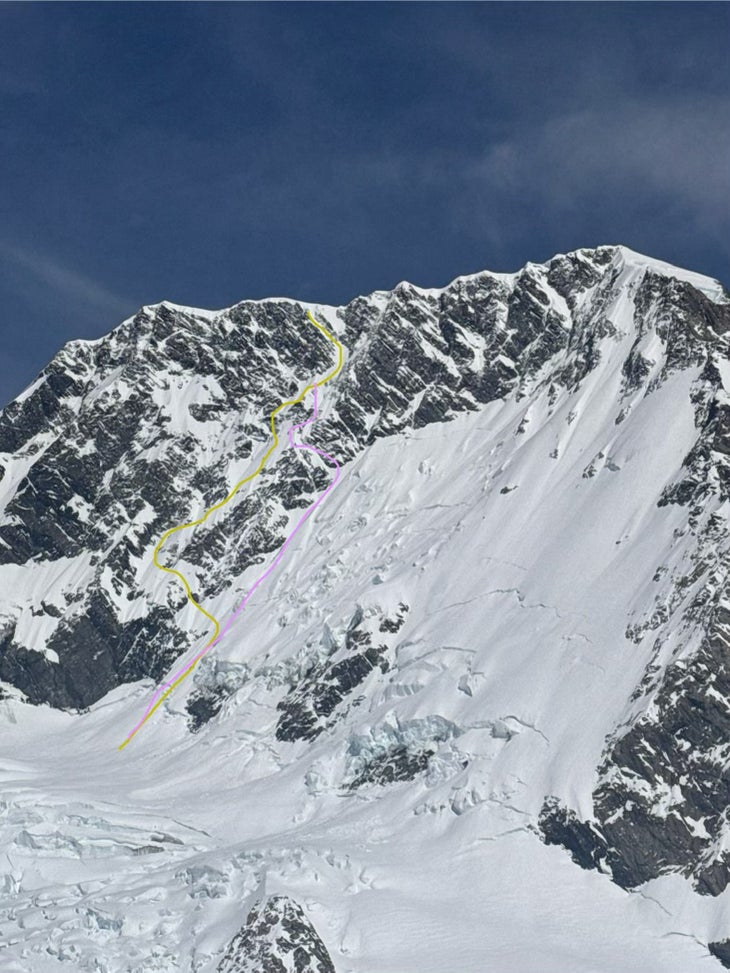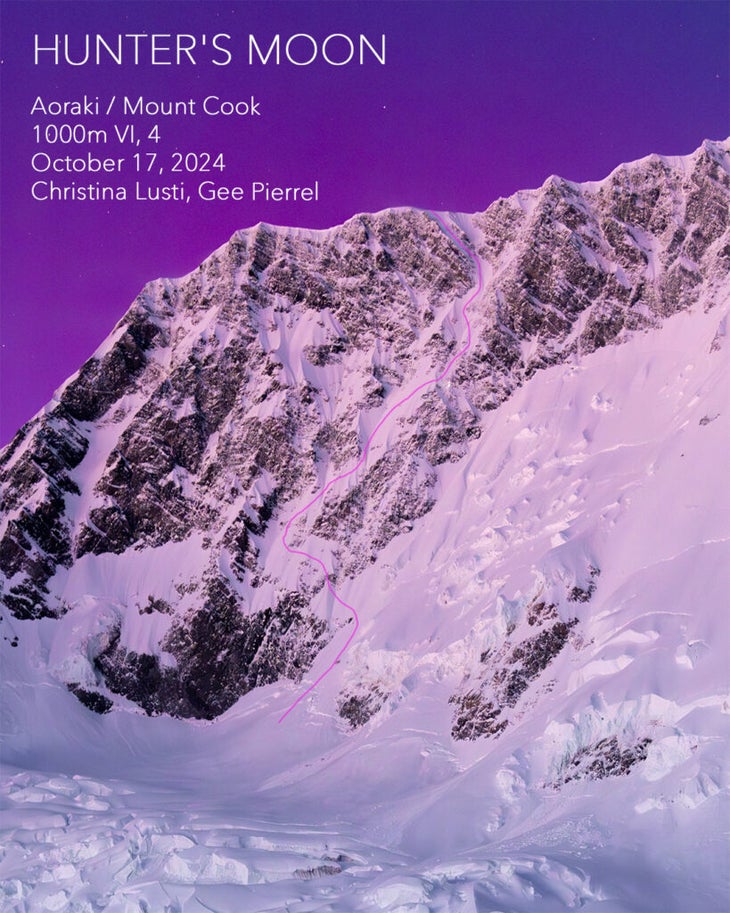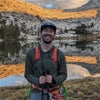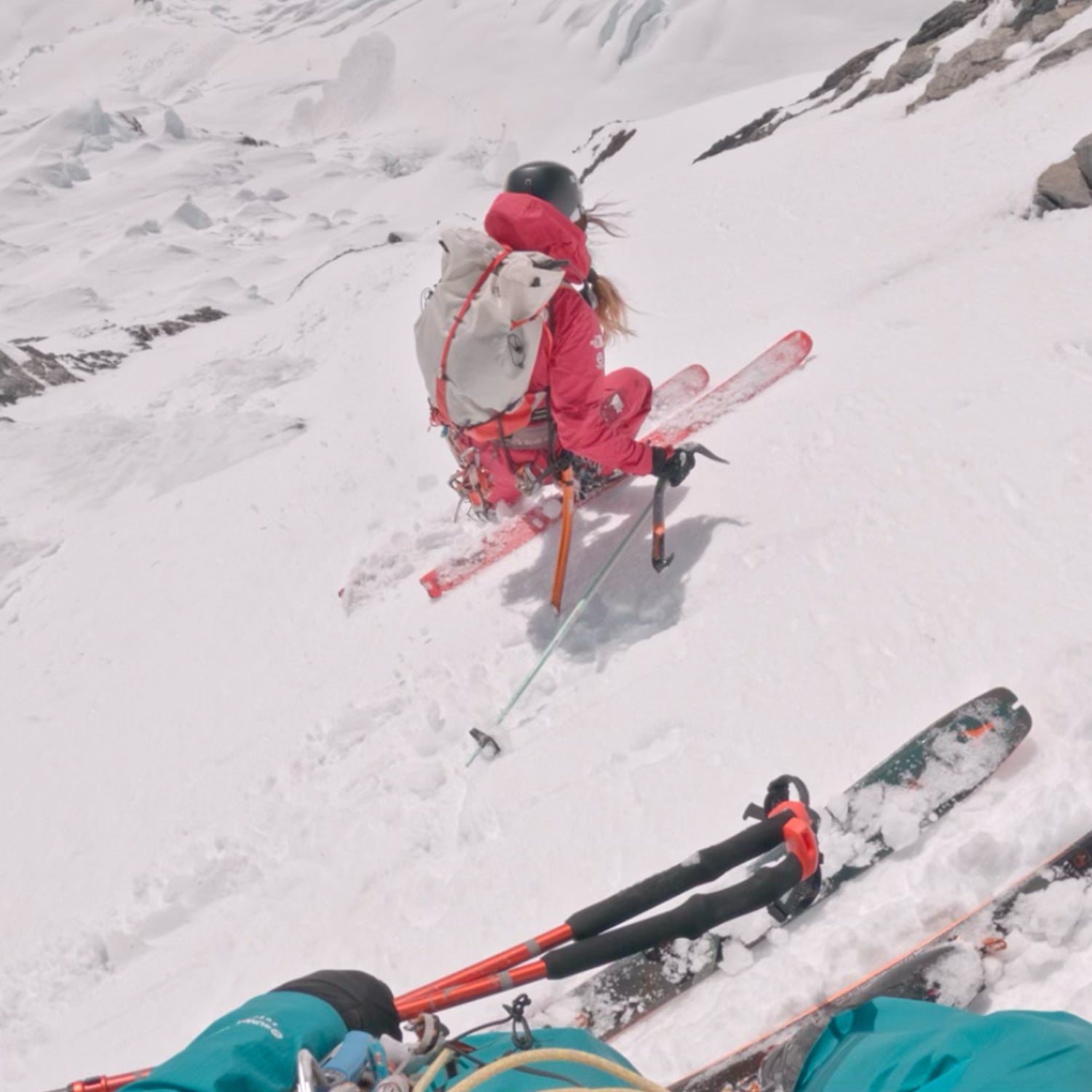On October 17, professional ski mountaineers Christina “Lusti” Lustenberger and Guillaume “Gee” Pierrel sunk their ice tools into the shoulder of New Zealand’s highest peak, 12,218-foot Aoraki, also called Mount Cook. They ascended the mountain under darkness, climbing over snow, rock, and ice beneath the aurora australis. Clicking into their skis atop their new line at 8 A.M., they spied the full moon and prepared to drop into their third big-mountain ski descent in just four days.
“We went on a bit of a rampage,” said Pierrel.
The line they descended, which they named Hunter’s Moon, after the Kiwi name for the full moon, was the most dangerous and demanding that either had skied. “Every single turn we made on that face had a serious consequence, because of the exposure,” Lusti told ���ܳٲ������.��
Lusti and Pierrel met on a North Face team trip in Chamonix this year, and quickly developed a strong ski partnership. Pierrel is an IFMGA guide known for skiing steep and technical descents in his home of Chamonix, but he’s also descended lines in the Himalayas and the Andes. In 2021, he skied a first descent from the summit of Gasherbrum II in Pakistan in alpine style with no supplemental oxygen.
Lusti, meanwhile, has scored several noteworthy accomplishments in 2024, including the first descent of Pakistan’s Great Trango Tower with Jim Morrison and Chantel Astorga on May 9. But the duo’s New Zealand rampage marked new territory for them both.
View this post on Instagram
Lusti first spotted Hunter’s Moon when she entered the Southern Alps on September 28. When Pierrel arrived on October 1, she decided to partner up with him to tackle a few lines.
New Zealand’s Southern Alps is home to famously fickle weather. The range is extremely close to the ocean and storms blow in quickly and often without warning. Lusti and Pierrel had spent the week prior skiing from a hut near Aoraki, but high winds and blowing snow kept them from being able to access their biggest objectives. During that time, they connected with Kiwi skiers Sam Smoothy and Will Rountreei, local legends who have been quietly ticking away extreme skiing in the range for the last few years. Together, the four athletes skied the Bowie Couloir, another line on Aoraki. Smoothy and Rountree’s efforts have brought attention to skiing in the Mount Cook Range, and Lusti and Pierrel credit the New Zealanders for piquing their interest.
“Sam and Will have shed some light on the steep skiing in this range,” said Pierrel. “They’re bringing a new vision to New Zealand and we got on that train.”
Once the snow stopped falling and their weather window opened, Lusti and Pierrel took full advantage of clear conditions. They first climbed and skied the glaciated southeast face of 9,853-foot Mount Dixon. They named their route the “Mullet Direct,” in honor of the alpinist Mike Gardner, an inspiration to both Lusti and Pierrel. Then, just two days later, they skied the cracked-up east face of 10,856-foot Mount Vancouver. The pair named that first descent “Uncle Pete,” for Lusti’s uncle, who died a few days later—but not before he saw photos of the line they dedicated to him.
On October 17, the duo began climbing Aoraki to ski by far the most demanding line either skier had ever attempted. Lusti and Pierrel climbed the rarely-repeated Jones route on the mountain’s east face, a sustained 55-degree series of ice and rock runnels that ascends from the mouth of the Caroline Glacier to the shoulder of the peak. “Our vision was always to descend this intricate ramp system further skier’s right,” Lusti said. “We started their descent at 9:15 A.M. in unforgiving icy snow conditions. Committed to the exposure, one turn at a time, we pushed each other out of our comfort zones.”

The icy surface required the utmost precision and attention, but Lusti and Pierrel were able to link turns down the entire face, save for one short section of glacier ice near the top that was too firm for their edges. They made a short rappel to navigate that section.
The ramp they skied looked improbable from the glacier floor, and even climbing up the pair of skiers could barely make out that it was skiable. Pierrel had spotted the exit ramp during an aborted attempt on the Jones route the week prior, which allowed the duo to escape the line cleanly on skis without needing to rappel. They backed off on the earlier attempt because the strong winds ripped the snow off the face, leaving bare ice.
But when the storm subsided, the gap of nice weather was longer than Lusti and Pierrel anticipated. That amount of time let them get acquainted with the snow quality and boosted their confidence when the time came to climb and ski Aoraki. “Going back-to-back with the lines like that allowed us to build a really intimate relationship with the snow conditions,” Lusti said. “We were so in tune with how the snow was changing that we were able to step out further each day into steep and dangerous terrain.” By the time the duo dropped in on Hunter’s Moon, they were able to anticipate some of the surprises the mountain threw at them.
New Zealand’s finicky snowpack added to the descent’s difficulty. Strong winds off the Tasman Sea create an transform the snowpack into an inconsistent and patchy surface. In any one descent, skiers are likely to encounter névé ice, refrozen surfaces, and loose, dry powder. “You need to be extremely calculated from turn to turn, constantly anticipating the conditions ahead of you—and whether or not you can surmount them with your edges,” Lusti said. ” You’re basically just clinging for your life at every turn.” That intimate knowledge of the snowpack proved paramount to the safety of the descent.
But equally important was the trust that the two built in the process. Lusti was holding the weight of the loss, but Pierrel helped her focus and be present in the mountains. “Having a partner like Gee who trusted what we were doing and who had a complete focus in the vision we were trying to accomplish allowed me to feel confident and push away my distractions,” Lusti said. Reflecting on Hunter’s Moon in particular, Lusti said she was grateful to have such a brilliant partner who pushed her forward when she needed it and was willing to be pushed by her in return.
Pierrel told ���ϳԹ��� that he felt lucky to be accompanying Lusti on the peak. “I’ve been skiing with the best athletes in Chamonix, and Christina was so impressive,” Pierrel said. He described her making turns on tiny ribbons of ice while he was using his ice axe to help him slide down.
To push the envelope of what’s possible in ski mountaineering, the stars have to align. Skiers need the right snow, the right partner, the right motivation, and even the right luck. “On that day we went, under the full moon, we had this incredible night sky,” Lusti said. “That’s when hard times’ silver linings appear. We were able to find such an incredible flow within our partnership and put down lines that were really special for the people in our community.” Under the full moon, the southern lights, and a sky full of stars, Lusti and Pierrel were in exactly the right place to make skiing history.



